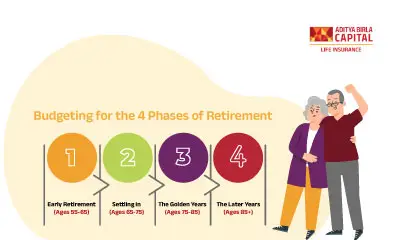Let's Invest in Retirement Plan This Diwali| ABSLI


Get Guaranteed Returns After a Month^
Unlock the Power of Smart Investment!


-
 Table of Contents
Table of Contents
1) The ‘What’
2) Why to Invest in Retirement Plan?
3) How to Create Retirement Corpus?
a) Estimate the Retirement Corpus That You Would Need
b) Set Aside a Part of Your Income Every Month Towards the Estimated Corpus
i) Assess Your Risk Appetite and Investment Horizon
ii) Plan Your Taxes#
A. Life Insurance Deferred Pension Plans
B. National Pension System (NPS)
C. Public Provident Fund
D. ELSS Schemes of Mutual Funds
E. 5-year Fixed Deposit Schemes
F. National Savings Certificates
iii) Pick Suitable Avenues
The Bottom Line
About Author
ABSLI DigiShield Plan
-
Disclaimer
1 Male age 60 years, Annuity Option -Life Annuity, Annuity Payout Frequency-Annual, Option chosen of Premium, Purchase Price Rs.10,00,000, Level Annuity, PPT: Single Pay, Single Life. Receive Annuity Rs.87,314 per annum
ABSLI Guaranteed Annuity Plus is a Non-Linked, Non-Participating, General Annuity Plan (UIN: 109N132V07)
2https://www.mutualfundssahihai.com/en/calculators
3 Provided all due premiums are paid.
4https://cleartax.in/s/section-80ccc
5https://cleartax.in/s/section-80ccd
6https://economictimes.indiatimes.com/wealth/tax/invest-more-than-rs-1-5-lakh-in-elss-mutual-fund-to-claim-full-benefit-under-section-80c-experts/articleshow/82901058.cms
7https://cleartax.in/s/section-80ttb
8https://cleartax.in/s/nsc-national-savings-certificate
*Tax benefits are subject to changes in tax laws. Kindly consult your financial advisor for more details.
#https://incometaxindia.gov.in/tutorials/20.%20tax%20benefits%20due%20to%20health%20insurance.pdf
ADV/10/22-23/1967
Subscribe to our Newsletter
Get the latest product updates, company news, and special offers delivered right to your inbox
Thank you for Subscribing
Stay connected for tips on insurance and investments

 Home Loans
Home Loans
 Personal
Loans
Personal
Loans
 SME Loans
SME Loans
 Business Loans - Udyog
Plus
Business Loans - Udyog
Plus
 Loan against Securities
Loan against Securities
 Mutual Funds
Mutual Funds
 Stock and
Securities
Stock and
Securities
 Portfolio
Management Services
Portfolio
Management Services
 Pension Funds
Pension Funds
 Life
Insurance
Life
Insurance
 Health
Insurance
Health
Insurance
 Wellness
Solutions
Wellness
Solutions
 Pay Bills
Pay Bills
 Pay anyone
Pay anyone
 Pay on call
Pay on call
 Payment
Lounge
Payment
Lounge
 ABC Credit
Cards
ABC Credit
Cards

 1800-270-7000
1800-270-7000









